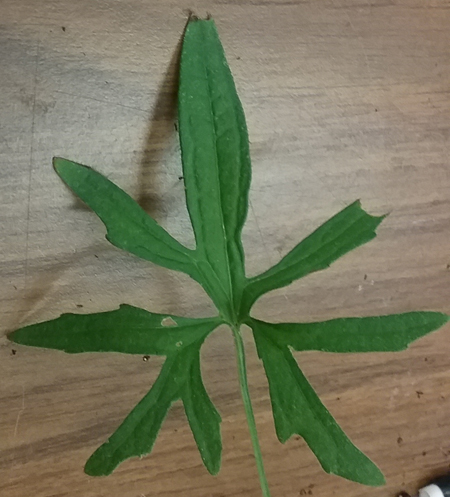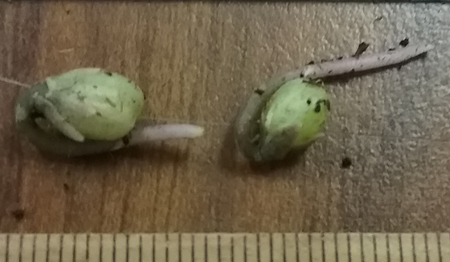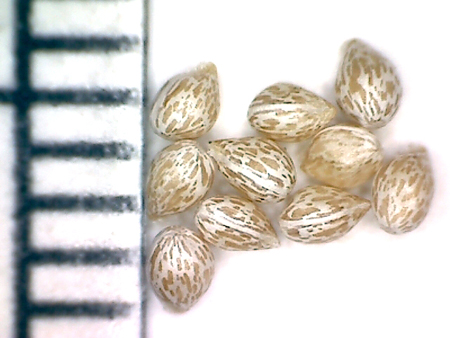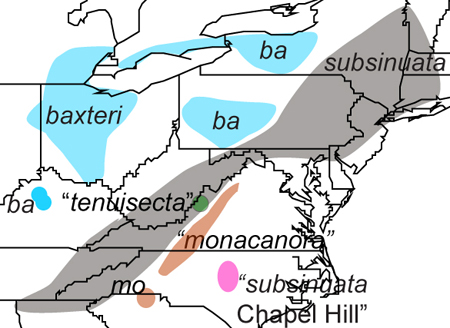Viola subsinuata [species complex]
Common names:
Early Blue Violet, Hand-leaved Violet, Wavy-leaved Violet
Synonyms:
See subordinate taxa.
Subordinate taxa belonging to this species:
Viola subsinuata (Greene) Greene [sensu stricto]
Viola "subsinuata Chapel Hill"
Description:
Acaulescent rosulate perennials from thick rhizome, ≤ 28 cm tall; foliage and peduncles green, lower surface of leaf blades, petioles, peduncles often tinged with purple, mostly moderately to densely hirsute; stipules free, irregularly glandular-fimbriate; homophyllous, leaves ascending, smallest leaf blades palmatifid, largest leaf blades in V. subsinuata sensu stricto deeply biternately divided into 7 or 9 narrowly linear or linear-lanceolate lobes, the lateral second-order lobes of the terminal primary division attached medially and suberect or ascending to spreading, outline narrowly ovate to ovate during chasmogamous flower, broadening to broadly ovate or reniform in fruit, base cordate, margins of the ultimate segments in fruit entire or with 1–2 inconspicuous short appressed or incurved teeth on either side, margins ciliate, apex acute to obtuse, or largest leaf blades subternately divided, secondary lobes on terminal primary division rhombic-lanceolate, divergent, lateral primary divisions rhombic in outline, all distinctly narrowed into a short "petiolule" at base, all lobes with an additional slender elongate lobe on outside margin (leaf vaguely resembling Anemone multifida) (V. subsinuata [Chapel Hill variant]); chasmogamous peduncle held among the leaves; chasmogamous flower ≤ 25 mm; calyx glabrous, ciliate; lowest sepals oblong to ovate, obtuse to rounded; auricles short and entire, not elongating in fruit; corolla blue to purple, throat white; spur short-globose; lateral petals densely bearded with slightly clavate hairs, spurred petal glabrous; chasmogamous capsule green; cleistogamous flowers produced after chasmogamous, peduncle prostrate but arching upward just before dehiscence, shorter than petioles; cleistogamous capsule 6–8 mm, green drying tan with purple spots or blotches, glabrous; seeds 1.8–2.1 × 1.1–1.3 mm, white or ivory to light reddish-brown with small prominent yellow-brown to dark brown streaks (V. subsinuata sensu stricto; seeds of V. subsinuata [Chapel Hill variant] are unknown); 2n=54.
Similar species:
This species is most similar to other homophyllous cut-leaved taxa in the Pedatifida and Subsinuata species groups. It differs from V. brittoniana and V. pedatifida by its densely hirsute foliage, short rounded auricles, oblong to ovate ciliate obtuse to rounded sepals, glabrous spurred petal, heavily spotted cleistogamous capsule on short prostrate peduncle, and pale to light reddish-brown seeds with small streaks. It can be distinguished from V. monacanora in its densely hirsute foliage, oblong or narrowly ovate ciliate obtuse to rounded sepals, and pale to light reddish-brown seeds with small streaks. It can be distinguished from V. baxteri by the several features of leaf dissection noted in the key, as well as its prominently streaked seeds. It is easily separated from V. tenuisecta in its densely hirsute foliage, biternately divided leaf blades with proportionally broader ultimate segments, and oblong or narrowly ovate ciliate obtuse to rounded sepals.
Ecology:
Sandy or loamy soils in rich dry and dry-mesic forests, probably associated with mafic rocks in some areas.
Distribution:
Mainly at higher elevations in the c. and s. Appalachian Mountains, extending onto the Piedmont northward, and with isolated populations in the e. Piedmont of NC; VT, CT and c. PA south to c. NC, ne. AL and e. KY.
Rarity:
See subordinate taxa.
Phenology:
Chasmogamous flower April–May, chasmogamous fruit April–June, cleistogamous fruit May–August.
Affinities:
This species belongs to the Acaulescent Blue Violet lineage, sect. Nosphinium W.Becker, subsect. Boreali-Americanae (W.Becker) Gil-ad, in the Subsinuata species group.
Hybrids:
See subordinate taxa.
Comments:
Elliott (1817) and other botanists followed Linnaeus (1753) in applying the name V. palmata to a heterophyllous violet. Brainerd (1910c) opposed this interpretation, arguing that Linnaeus's name should be attributed to the homophyllous cut-leaved violet predominately distributed in the Appalachian Mountains and associated uplands, and he asserted that the widespread eastern heterophyllous violet should be treated as V. triloba. Brainerd's proposals were followed by Brainerd (1921b), Brainerd Baird (1942), Fernald (1950), Henry (1953a), Alexander (1963), Russell (1965), Scoggan (1978), Strausbaugh and Core (1978), and Swink and Wilhelm (1979). McKinney (1992) reexamined original material of the name V. palmata L. and Linnaeus's protologue and came to the opposite conclusion, that there was abundant evidence to indicate that Linnaeus intended the name for a heterophyllous violet long-treated as V. triloba. Gil-ad (1995, 1997, 1998) rejected McKinney's interpretation, hypothesizing that the lectotype of V. palmata had macromorphological features suggestive of hybridization. Gil-ad studied a modest number of samples from disparate parts of the range of the Subsinuata species group as a whole and, unsurprisingly, found substantial divergence in macromorphological features of the specimens and a lack of unique traits defining them as a single taxon; he also found confusing patterns of micromorphological traits in the seeds suggestive of various hybrids involving V. pedatifida and other undivided-leaved species. He dismissed the assemblage as a series of hybrid derivatives. Ballard (2000, 2013), McKinney and Russell (2002), Haines et al. (2011), Weakley et al. (2012), and Little and McKinney (2015) adopted McKinney's interpretation of the names V. palmata L. and V. subsinuata, in most instances applying the former name to a broadly delimited assemblage of several species accepted here as distinct. Ballard (1995) and Voss and Reznicek (2012) merged the homophyllous cut-leaved violets (excluding V. pedatifida) and heterophyllous violets of Michigan into V. ×palmata and V. palmata, respectively, whereas Gleason and Cronquist (1991) merged several distinct heterophyllous and homophyllous cut-leaved taxa under V. palmata var. palmata. For obvious reasons, the nomenclatural confusion involving the
Literature Cited:
Alexander, E. J. 1963. Violaceae. In Gleason, H. A., The new Britton and Brown illustrated flora of the northeastern United States and adjacent Canada. Hafner Publishing Co., Inc., New York, NY. 552-567.
Ballard Jr., H. E. 1995 ["1994"]. Violets of Michigan. Michigan Botanist 33: 131-199.
Ballard Jr., H. E. 2000. Violaceae. In Rhoads, A. (ed.). Flora of Pennsylvania. University of Pennsylvania Press, Philadelphia, PA. 700-710.
Ballard Jr., H. E. 2013. Violaceae. In Yatskievych, G., Flora of Missouri. Missouri Botanical Garden Press, St. Louis, MO. 1218-1243.
Brainerd, E. 1910c. Viola palmata and its allies. Bulletin of the Torrey Botanical Club 37: 581-590, plate 36.
Brainerd, E. 1921b. Violets of North America. Vermont Agricultural Experiment Station Bulletin 224: 1-172.
Brainerd Baird, V. 1942. Wild violets of North America. University of California Press, Berkeley, CA.
Fernald, M. L. 1950. Violaceae. In Gray's Manual of Botany, 8th ed. American Book Company, New York, NY. 1022-1042.
Elliott, S. 1817. A sketch of botany of South Carolina and Georgia. J. R. Schenck, Charleston, SC.
Gil-ad, N. L. 1995. Systematics and evolution of Viola L. subsection Boreali-Americanae (W. Becker) Brizicky. Ph.D. dissertation. University of Michigan, Ann Arbor, MI.
Gil-ad, N. L. 1997. Systematics of Viola subsection Boreali-Americanae. Boissiera 53: 1-130.
Gil-ad, N. L. 1998. The micromorphologies of seed coats and petal trichomes of the taxa of Viola subsect. Boreali-Americanae (Violaceae) and their utility in discerning orthospecies from hybrids. Brittonia 50: 91-121.
Gleason, H. A., and A. Cronquist. 1991. Violaceae. In Manual of vascular plants of northeastern United States and adjacent Canada, 2nd ed. New York Botanical Garden, Bronx, NY. 157-163.
Haines, A., E. Farnsworth, and G. Morrison. 2011. Violaceae. In Flora Novae Angliae. Yale University Press, New Haven, CT. 873-886.
Henry, L. K. 1953a. The Violaceae in western Pennsylvania. Castanea 18(2): 37-59.
Linnaeus, C. 1753. Species Plantarum. Impensis Laurentii Salvii, Stockholm, Sweden.
Little, R. J., and L. E. McKinney. 2015. Violaceae. In Flora of North America: Cucurbitaceae to Droseraceae, 106. Oxford University Press, New York, NY.
McKinney, L. E. 1992. A taxonomic revision of the acaulescent blue violets (Viola) of North America. Sida, Botanical Miscellany 7: 1-60.
McKinney, L. E., and N. H. Russell. 2002. Violaceae of the southeastern United States. Castanea 67: 369-379.
Russell, N. H. 1965. Violets (Viola) of the central and eastern United States: An introductory survey. Sida 2: 1-113.
Scoggan, H. J. 1978. Violaceae. In Flora of Canada, Part 3–Dicotyledoneae (Saururaceae to Violaceae). National Museums of Canada. Ottawa, Canada. 1103-1115.
Strausbaugh, P. D., and E. L. Core. 1978. Violaceae. In Flora of West Virginia, 2nd ed. Seneca Books, Inc., Morgantown, WV. 644-658.
Swink, F., and G. Wilhelm. 1979. Violaceae. In Plants of the Chicago region, 2nd ed. revised and expanded. Morton Arboretum, Lisle, IL. 384, 801-810.
Voss, E. G., and A. A. Reznicek. 2012. Violaceae. In Field manual of Michigan flora. The University of Michigan Press, Ann Arbor, MI. 913-922.
Weakley, A. S., J. C. Ludwig, and J. F. Townsend. 2012. Violaceae. In Flora of Virginia. BRIT Press, Fort Worth, TX. 963-975.

Chasmogamous flowering habit of Viola subsinuata sensu stricto by Bruce Sorrie

Chasmogamous flowering habit of Viola "subsinuata Chapel Hill" from herbarium specimen: NC, [Orange Co.], Chapel Hill, Sandy soil of fairly open but damp mixed woods by road behind [Kenan Memorial] stadium, Sparse, 18 Apr 1949, D. E. Kirk 72 (NCU)

Leaf during cleistogamous fruit of Viola subsinuata sensu stricto (transplanted plant from VA, Bath Co., Beards Mountain, 1/3 way up steep slope above Wallawhatoola Road walking bridge over Cowpasture River) by Jennifer Hastings

Cleistogamous fruits of Viola subsinuata sensu stricto (transplanted plant from VA, Bath Co., Beards Mountain, 1/3 way up steep slope above Wallawhatoola Road walking bridge over Cowpasture River) by Jennifer Hastings

Seeds of Viola subsinuata sensu stricto (transplanted from VA, Augusta Co., Blue Ridge Parkway, west of Greystone Farm north-northwest of Love Gap) by Jennifer Hastings

Map of taxa in the Subsinuata species group by Harvey Ballard